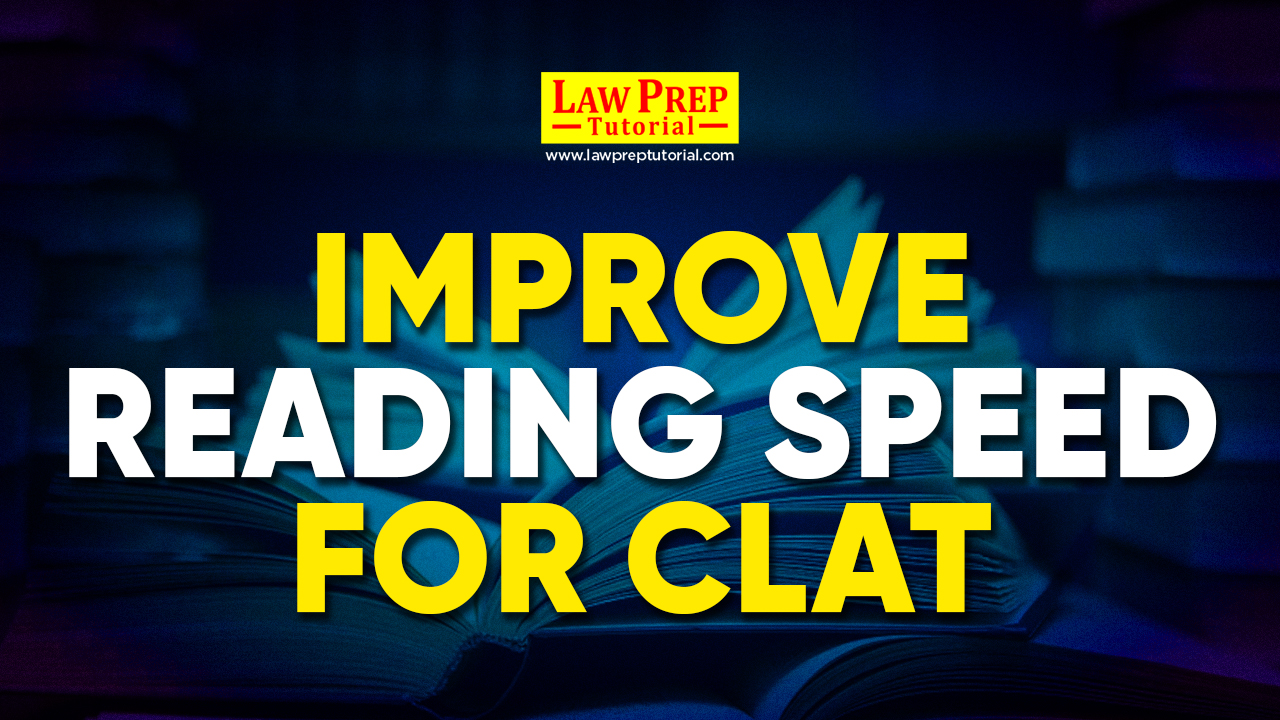Welcome, aspiring legal eagles! Are you gearing up for the CLAT 2025 exam? If so, then you’re likely aware of the importance of efficient reading speed for CLAT. In the competitive arena of CLAT, where time is of the essence, honing your reading speed can be a game-changer.
Fear not, as we begin a journey to enhance your reading speed, ensuring you’re well-prepared to tackle the CLAT exam with confidence. This blog will talk about six ways to improve your reading speed while doing CLAT preparation.
Importance of Reading Speed for CLAT Exam
Efficient reading speed isn’t just about flipping pages quickly; it’s about comprehending and retaining information effectively. In the CLAT exam, time constraints loom large. Thus, the ability to read faster can give you a decisive advantage. Let’s delve deeper into why speed reading for CLAT exam is paramount:
Comprehension under Time Constraints:
CLAT passages are often dense and intricate. By enhancing your reading speed, you’ll be better equipped to digest complex information within the allotted time frame.
Accuracy Enhancement:
Speed reading isn’t about sacrificing accuracy for velocity. Instead, it’s about striking a balance between speed and precision, reducing the likelihood of overlooking crucial details.
Time Optimization:
By reading faster, you’ll free up precious minutes to tackle challenging questions and revisit answers. This time management prowess can make all the difference in acing the CLAT exam.
Confidence Boost:
Mastering reading speed instils a sense of confidence and poise. Further, it alleviates exam anxiety and enables you to approach each passage with assurance.
In essence, sharpening your reading speed is akin to honing your sword before entering the battlefield of CLAT.
How to Read Faster for CLAT 2025? Techniques and Strategies
Whether preparing for exams or simply aiming to become a more efficient reader, these strategies will help you unlock the secrets to swift comprehension. Below, learn how to read faster and improve your reading speed for CLAT:
1. Skim and Scan Method
The Skim and Scan method is a potent weapon in your arsenal when time is of the essence. Here’s how to wield it effectively:
Skim for Structure:
Begin by swiftly perusing the passage to grasp its central theme and organizational structure. This initial overview provides a roadmap for deeper exploration.
Keyword Identification:
Next, hone in on keywords and phrases that encapsulate essential information within the text. These serve as signposts, guiding your attention to pertinent details.
Rapid Scanning:
Armed with identified keywords, scan the passage briskly, focusing on extracting relevant information. Train yourself to discern vital details amidst the sea of text, refining this skill through regular practice.
Repetition and Reinforcement:
Like any skill, mastering the Skim and Scan method requires consistent practice. Incorporate this technique into your daily study routine, gradually enhancing your proficiency over time.
Remember, the goal isn’t merely to skim through passages superficially but to extract meaningful insights efficiently.
2. Improve Vocabulary and Language Proficiency
Expanding your lexical repertoire and refining language proficiency can work wonders for your reading speed. Here’s why it matters:
Word Recognition:
A robust vocabulary facilitates swift recognition of words, enabling you to navigate through passages with ease.
Sentence Structure Mastery:
Familiarity with diverse sentence structures enhances reading fluency, allowing you to decipher complex sentences more expediently.
Contextual Understanding:
Exposure to varied vocabulary broadens your understanding of contextual nuances. This empowers you to grasp the intended meaning of passages swiftly.
To bolster your vocabulary, engage in activities such as reading diverse genres and employ vocabulary-building apps.
3. Eliminate Subvocalization
Subvocalization, or silently pronouncing words as you read. This can act as a speed bump in your reading journey. Here’s how to mitigate this habit:
Awareness and Acknowledgment:
Begin by recognizing when subvocalization occurs during your reading process. Heightened self-awareness is the first step towards overcoming this impediment.
Silent Reading Practice:
Train yourself to read silently without mentally vocalizing each word. Focus on absorbing the meaning of the text through visual processing rather than auditory simulation.
External Distractions:
Minimize external distractions during your reading sessions to deter subconscious subvocalization. Create an environment conducive to silent reading that is free from noise and interruptions.
By breaking free from subvocalization, you’ll streamline your reading pace while simultaneously enhancing comprehension.
4. Enhance Concentration and Focus
Distractions can derail your reading momentum and hinder comprehension. Here’s how to cultivate unwavering focus:
Environmental Optimization:
Create a designated study space conducive to concentration and free from external disturbances. Minimize clutter and establish a comfortable yet disciplined ambience.
Mindfulness Practices:
Incorporate mindfulness techniques such as deep breathing and focused attention exercises into your daily routine. These practices enhance cognitive control and mitigate distractions.
Goal Setting:
Set specific reading goals for each study session and monitor your progress diligently. Break down large tasks into manageable chunks, celebrating milestones along the way.
By fostering a laser-sharp focus, you’ll navigate through passages with heightened efficiency and comprehension.
5. Active Engagement and Annotation
Active engagement with the text can significantly augment your reading speed and comprehension. Here’s how to harness this approach effectively:
Annotation Techniques:
Employ annotation strategies such as highlighting, underlining, and marginal notes to interact with the text actively. These visual cues serve as anchors, facilitating swift information retrieval during subsequent review.
Question-Driven Reading:
Approach each passage with a curious mindset, generating questions based on the title or introductory paragraphs. Actively seek answers as you progress through the text, fostering deeper engagement and retention.
Summarization Practice:
After completing a passage, challenge yourself to summarize its key points concisely. This exercise reinforces understanding while honing your ability to distil information swiftly.
By adopting an active approach to reading, you’ll transform passive consumption into an immersive learning experience.
6. Regular Practice with Mock Tests
Consistent practice is the linchpin of success when it comes to improving reading speed for the CLAT exam. Here’s why CLAT mock tests are invaluable:
Simulated Exam Environment:
Mock tests replicate the conditions of the actual CLAT exam, acclimatizing you to time constraints and performance pressures.
Diagnostic Assessment:
Analyze your performance on mock tests to identify areas of strength and weakness. Tailor your study plan accordingly, focusing on areas that require improvement.
Strategic Adaptation:
Experiment with different reading strategies and approaches during mock tests to ascertain what works best for you. Refine your techniques based on feedback and performance analysis.
Remember, consistent practice is the key to unlocking your full potential and mastering the art of speed reading.
Winding Up
Improving reading speed for the CLAT 2025 or CLAT 2026 exam isn’t a sprint; it’s a marathon that demands dedication, perseverance, and strategic practice. Implement the techniques outlined above and maintain a disciplined study regimen. By doing this, you’ll undoubtedly enhance your reading velocity and conquer the CLAT exam with confidence and competence.
So, brace yourself for the challenge and embrace the journey of self-improvement. And let your newfound reading prowess propel you towards academic excellence. Success awaits those who dare to read faster and read smarter!
Suggested Reading:



